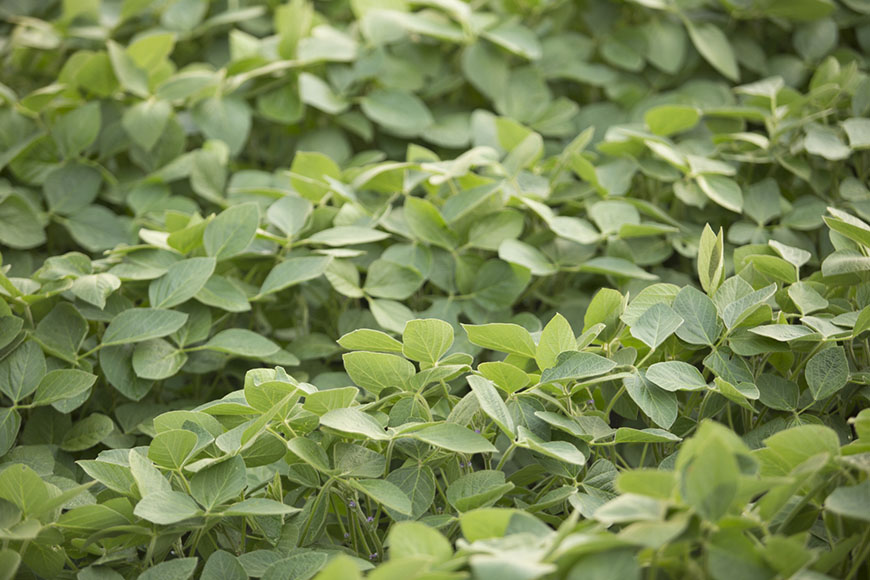Managing Early Season Rain Stress

If heavy spring rains hit your area shortly after planting, your corn and soybean crops face stress threats both before and after emergence. Understanding how these stress factors affect your fields can help you mitigate the effects of excessive moisture and preserve optimum yield potential for your crops.
Soil Response to Heavy Rains
Only a certain amount of water can penetrate soil per hour. During the first hour of a rain event, water will infiltrate soil fairly quickly. However, as the rain continues, the large soil pores (macropores) fill with rain water and the soil infiltration rate declines. When the rainfall rate surpasses the soil’s infiltration rate, water will run off the soil surface, taking soil with it and causing erosion.
Large amounts of rain can do further damage by breaking apart soil aggregates that are responsible for the structure of the soil, creating very small soil particles. These small soil particles will move with the water down into the soil profile and become lodged in the macropores. When the macropores are full, drying soils will form a very hard surface layer crust that creates a barrier for emerging seedlings and can reduce stands.
Recently Planted Corn
Soil crusting’s effect on recently planted corn will depend on weather conditions after the heavy rains. If light rains keep the soil surface moist, emergence will not be effected by soil crusting. However, it’s more likely that the soil will stay dry and cause emergence issues.
If crusting does occur, a rotary hoe can be used to break up the soil crust, and allow the corn plant to come through the soil. This needs to be done as soon as the soil dries out to avoid damaging emerging plants. If plants are emerging, a rotary hoe can still increase the final stand, but it should only be done if the increase in final stand would justify the damage that may be caused by rotary hoeing emerged corn.
The chart at the bottom of this article can be used to estimate how much yield loss will occur from any reduction in stand caused by soil crusting.
Emerged Corn
Corn that emerged before a heavy rain event often does not sustain any direct damage. However, heavy rains can splash soil into the young corn plant’s whorl. Because many corn diseases survive in crop residue on the soil, the chances of disease, such as anthracnose, infecting the plant increase. If a hybrid is susceptible to anthracnose when it receives heavy rains, I highly recommend treating the field with a fungicide at V5.
Recently Planted Soybeans
While recently planted soybeans will respond to soil crusting similarly to corn, stands tend to decrease more substantially, causing more risk. Also, because most soybeans will emerge within four to five days of planting when soil temperatures are warm, rotary hoeing must be done quickly to break up soil crusting.
After emergence, soybeans are more forgiving than corn when it comes to damage caused by rotary hoeing. However, be sure that the potential damage from the hoe will be outweighed by the possible increase in stand when soil crust is broken up. Final stand counts for soybeans should be above 90,000 plants per acre.
When saturated, cool soil conditions are present, conditions are favorable for soybean sudden death syndrome; plants could become infected with this pathogen within a couple days of planting.
Emerged Soybeans
Emerged soybeans generally are safe from heavy rains, although herbicides can splash onto plant leaves and burn the tissue. While this burning is usually cosmetic, it can cause some stand loss. Wait a week before making any replant decisions due to herbicide damage because soybeans are very resilient.
Estimating Yield Loss

Soil Response to Heavy Rains
Only a certain amount of water can penetrate soil per hour. During the first hour of a rain event, water will infiltrate soil fairly quickly. However, as the rain continues, the large soil pores (macropores) fill with rain water and the soil infiltration rate declines. When the rainfall rate surpasses the soil’s infiltration rate, water will run off the soil surface, taking soil with it and causing erosion.
Large amounts of rain can do further damage by breaking apart soil aggregates that are responsible for the structure of the soil, creating very small soil particles. These small soil particles will move with the water down into the soil profile and become lodged in the macropores. When the macropores are full, drying soils will form a very hard surface layer crust that creates a barrier for emerging seedlings and can reduce stands.
Recently Planted Corn
Soil crusting’s effect on recently planted corn will depend on weather conditions after the heavy rains. If light rains keep the soil surface moist, emergence will not be effected by soil crusting. However, it’s more likely that the soil will stay dry and cause emergence issues.
If crusting does occur, a rotary hoe can be used to break up the soil crust, and allow the corn plant to come through the soil. This needs to be done as soon as the soil dries out to avoid damaging emerging plants. If plants are emerging, a rotary hoe can still increase the final stand, but it should only be done if the increase in final stand would justify the damage that may be caused by rotary hoeing emerged corn.
The chart at the bottom of this article can be used to estimate how much yield loss will occur from any reduction in stand caused by soil crusting.
Emerged Corn
Corn that emerged before a heavy rain event often does not sustain any direct damage. However, heavy rains can splash soil into the young corn plant’s whorl. Because many corn diseases survive in crop residue on the soil, the chances of disease, such as anthracnose, infecting the plant increase. If a hybrid is susceptible to anthracnose when it receives heavy rains, I highly recommend treating the field with a fungicide at V5.
Recently Planted Soybeans
While recently planted soybeans will respond to soil crusting similarly to corn, stands tend to decrease more substantially, causing more risk. Also, because most soybeans will emerge within four to five days of planting when soil temperatures are warm, rotary hoeing must be done quickly to break up soil crusting.
After emergence, soybeans are more forgiving than corn when it comes to damage caused by rotary hoeing. However, be sure that the potential damage from the hoe will be outweighed by the possible increase in stand when soil crust is broken up. Final stand counts for soybeans should be above 90,000 plants per acre.
When saturated, cool soil conditions are present, conditions are favorable for soybean sudden death syndrome; plants could become infected with this pathogen within a couple days of planting.
Emerged Soybeans
Emerged soybeans generally are safe from heavy rains, although herbicides can splash onto plant leaves and burn the tissue. While this burning is usually cosmetic, it can cause some stand loss. Wait a week before making any replant decisions due to herbicide damage because soybeans are very resilient.
Estimating Yield Loss



